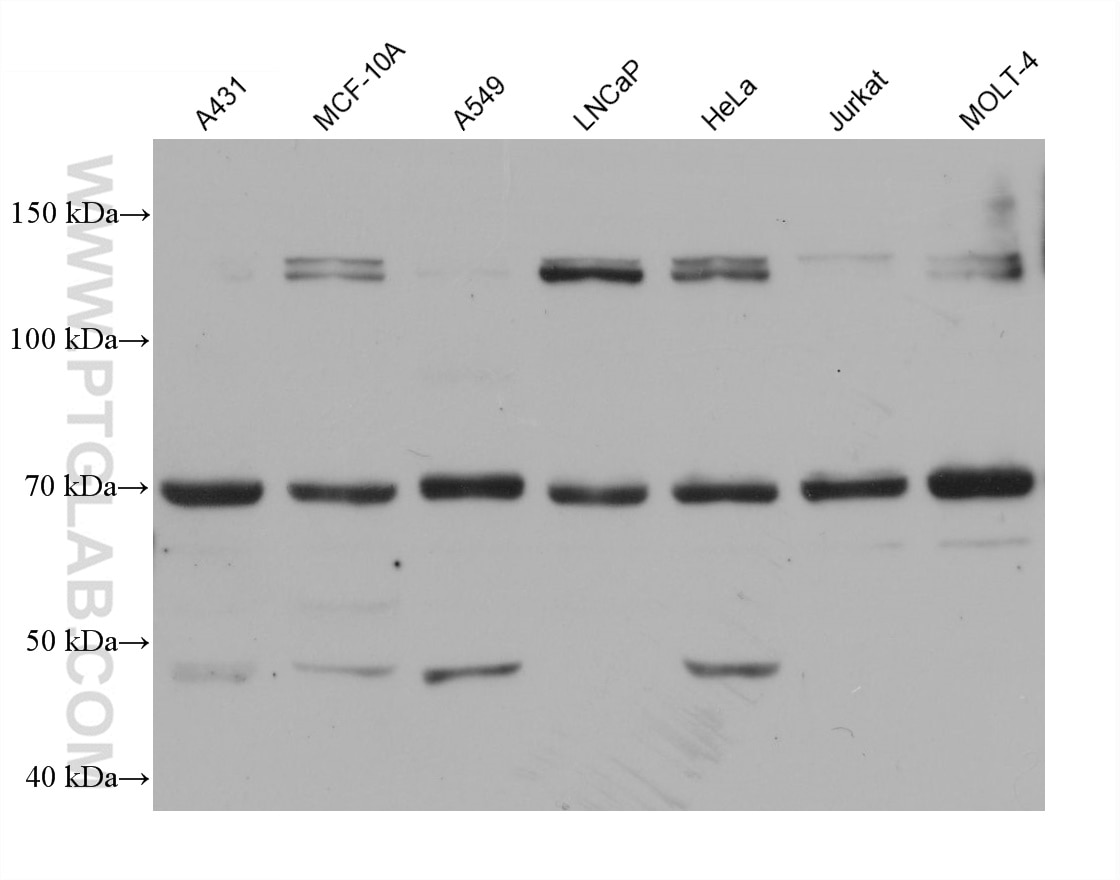AEG-1/MTDH Monoklonaler Antikörper
AEG-1/MTDH Monoklonal Antikörper für WB, ELISA
Wirt / Isotyp
Maus / IgG1
Getestete Reaktivität
human
Anwendung
WB, ELISA
Konjugation
Unkonjugiert
CloneNo.
1D8C2
Kat-Nr. : 68592-1-Ig
Synonyme
Galerie der Validierungsdaten
Geprüfte Anwendungen
| Erfolgreiche Detektion in WB | A431-Zellen, A549-Zellen, HeLa-Zellen, Jurkat-Zellen, LNCaP-Zellen, MOLT-4-Zellen |
Empfohlene Verdünnung
| Anwendung | Verdünnung |
|---|---|
| Western Blot (WB) | WB : 1:5000-1:50000 |
| It is recommended that this reagent should be titrated in each testing system to obtain optimal results. | |
| Sample-dependent, check data in validation data gallery | |
Produktinformation
68592-1-Ig bindet in WB, ELISA AEG-1/MTDH und zeigt Reaktivität mit human
| Getestete Reaktivität | human |
| Wirt / Isotyp | Maus / IgG1 |
| Klonalität | Monoklonal |
| Typ | Antikörper |
| Immunogen | AEG-1/MTDH fusion protein Ag5033 |
| Vollständiger Name | metadherin |
| Berechnetes Molekulargewicht | 582 aa, 64 kDa |
| Beobachtetes Molekulargewicht | 70-80 kDa |
| GenBank-Zugangsnummer | BC045642 |
| Gene symbol | MTDH |
| Gene ID (NCBI) | 92140 |
| Konjugation | Unkonjugiert |
| Form | Liquid |
| Reinigungsmethode | Protein-G-Reinigung |
| Lagerungspuffer | PBS mit 0.02% Natriumazid und 50% Glycerin pH 7.3. |
| Lagerungsbedingungen | Bei -20°C lagern. Nach dem Versand ein Jahr lang stabil Aliquotieren ist bei -20oC Lagerung nicht notwendig. 20ul Größen enthalten 0,1% BSA. |
Hintergrundinformationen
MTDH, also known as AEG-1, is a single-pass transmembrane protein with its gene located at chromosome 8q22 , the abnormalities of which have been identified in several tumor types. MTDH is overexpressed in a number of malignancies, such as breast cancer, malignant glioma, and neuroblastoma , and its overexpression is associated with poor clinical outcome. MTDH plays an important role in the regulation of carcinogenesis and tumor progression.
Protokolle
| Produktspezifische Protokolle | |
|---|---|
| WB protocol for AEG-1/MTDH antibody 68592-1-Ig | Protokoll herunterladen |
| Standard-Protokolle | |
|---|---|
| Klicken Sie hier, um unsere Standardprotokolle anzuzeigen |


